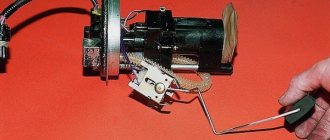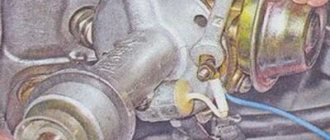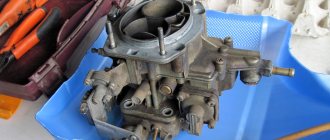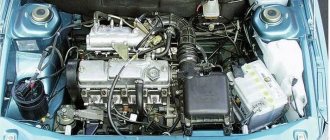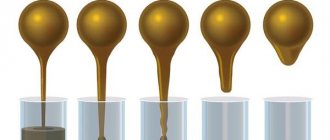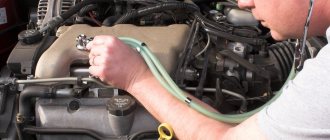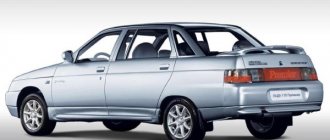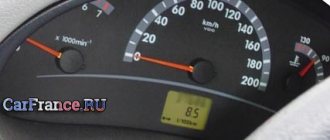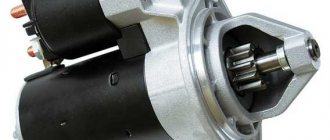Any car owner dreams that his car has as few breakdowns as possible and consumes as little gasoline as possible per 100 kilometers. However, we should not forget that a car is a complex unit that wears out over time. The development of the main working components leads to the fact that the driver feels a noticeable increase in the liters of fuel required to cover the same distance. At the same time, usually no one worries if this value has increased by 5-10%, but when instead of the usual 6.5 liters per hundred, 10.8 are spent, then this is already too much. Let's figure out what reasons influence excessive fuel consumption, how to deal with it and how to prevent it.
Vehicle malfunction
Before carrying out expensive diagnostics, the most obvious factors should be excluded. The first thing that comes to mind is an unscrupulous fuel sales point. Sometimes you can find gas stations where they regularly do not “top up” gasoline, which can be mistakenly taken for increased consumption. First of all, change the fuel purchase point and check the on-board computer readings again.
If the problem repeats even when changing gas stations, then you need to look for the cause in any malfunctions of the car. Let's look at the most common ones.
Piston group
A common reason is the exhaustion of the resource of the engine piston group. These faults occur on cars that have a mileage of 100 thousand kilometers or more. Due to constant friction (even with the use of high-quality lubricants and timely oil changes), piston rings become unusable, and additional clearance contributes to loss of compression levels.
As soon as this characteristic drops down, the engine is forced to add power to maintain the required speed level, which leads to increased fuel consumption. In this case, gasoline does not burn completely, since the engine is designed for a strictly defined level of compression. It is a proven fact that with age, all cars begin to consume more gasoline.
Faulty spark plugs or ignition coils
The first part of this problem is the spark plugs, which are responsible for igniting the fuel in the combustion chamber of the engine. Since these units are under heavy load, they are replaced after 33-35 thousand kilometers. When this resource is exhausted, carbon deposits form on the contact group of the spark plug, and the gap between the electrodes is damaged. All this leads to the fact that the spark plug does not always fire and the fuel does not burn completely. For the driver, this is reflected in increased fuel consumption. Replacing spark plugs is fairly easy to do, and the cost of a new set is not that high.
Speaking of the ignition coil, this electronic unit must supply an electrical impulse to the spark plug in time, precisely at the moment when it is necessary to ignite gasoline vapors in the combustion chamber. If the coil is configured incorrectly or the phases are out of order, this again leads to the problem that gasoline does not completely burn in the chamber. This is a serious malfunction, which, among other things, can be diagnosed by increased gasoline consumption. With such a breakdown, you need to urgently go to service.
Clogged injectors or carburetor
Another reason for increased fuel consumption is the lack of preventive maintenance of the fuel supply system. We are talking about injector nozzles and carburetors. The reason is that the fuel spray torch in the presence of pollution has a different shape, which is why the process of forming a mixture of gasoline vapor and air is disrupted. Physically, this manifests itself in the unstable operation of the engine - it “shakes”, the speed fluctuates and cannot reach its normal value.
In addition, there is the phenomenon of incomplete injection (due to deposits on the injectors). At the same time, at idle the engine runs normally, but when you try to add speed, this process occurs more slowly than usual and has no effect.
In total, these two reasons for increased consumption lead to the fact that the fuel mixture does not completely burn in the engine chamber, resulting in a power deficit, which the electronics seeks to compensate through additional supply. This is what causes the increase in consumption.
The most noticeable sign of such a malfunction is a sharp deterioration in the dynamics of the car, in which pressing the gas pedal does not cause a good response - the speed increases slowly, and after increasing it also slowly decreases. To prevent this situation, it is necessary to regularly clean the injection system.
Lambda probe failure
An increased “appetite” for gasoline can be caused by sensor malfunctions. The most common malfunction of the lambda probe. This name hides the oxygen sensor, which is contained in the fuel mixture. Based on the information received, the electronic vehicle control system makes additional adjustments to the composition of the fuel mixture:
- You can add gasoline to the combustion chamber if information about a high oxygen content is received from the oxygen sensor;
- You can reduce the amount of fuel if there is too little oxygen.
If the sensor does not work correctly, the system makes an incorrect calculation, which is why the need for fuel increases sharply. When diagnosing increased consumption, it is necessary to check the operation of the lambda probe.
Catalyst
In the exhaust gas system, the catalytic converter serves as a barrier that traps toxic exhaust gases, catalytically oxidizing them into harmless compounds. Malfunctions of this unit can cause an increase in fuel consumption, as well as a decrease in engine power.
The operating principle is as follows - if the catalyst is burnt out or damaged, then it begins to filter exhaust gases noticeably worse, creating serious resistance to the gas-air flow. The electronic system receives this signal as a sharp shift in the ratio in the balance of the air-fuel mixture, giving a signal about the need for additional enrichment with gasoline. The meaning is simple - since the load has increased, it is necessary to add power to the engine, for which more fuel is supplied.
All this leads to a chain of events where a clogged catalyst provokes the formation of a mixture richer in gasoline, and this, in turn, further damages the catalyst and consumes more fuel. The neutralizer may become unusable for the following reasons. Reasons for excessive fuel consumption:
- Insufficient level of fuel quality;
- Untimely prevention of the engine injection system;
- Broken spark plugs.
Electronic control unit
An electronic unit is a device that collects information from sensors installed in the main components of the car, making decisions on adjusting the engine operating mode based on the data. Therefore, the first ECU malfunction is associated exclusively with the abnormal operation of the sensors:
- Temperature sensor. These sensors take temperature readings at the coolant and exhaust manifold. If the values are too high, then the fuel supply is reduced, and if the values are too low, then, on the contrary, it increases. Accordingly, in any case, the ECU will incorrectly regulate the level of gasoline supply;
- Throttle position sensor. This sensor is responsible for analyzing engine operation in idle mode, as well as in the mode of a sharp increase in load. The ECU, perceiving this data, incorrectly forms the composition of the fuel-air mixture, which leads to a drop in power as gasoline consumption increases;
- Incoming air quantity sensors. The amount of air supplied to the engine is measured, on the basis of which the amount of fuel required is calculated. There is only one consequence - there is excessive fuel consumption;
Fuel filter
The problem may not always be hidden in complex electronic components or within the engine design. Sometimes it’s a banal fuel filter. The service life of modern fuel filter elements is no more than 30 thousand kilometers; they must be changed in a timely manner.
If the filter is clogged, fuel enters the injectors with lower pressure than required. Accordingly, the ECU reacts adequately, increasing the injection time of gasoline into the combustion chamber. Since the contamination on the filter is not uniform, pressure surges in the system often occur to which the electronics do not respond. As a result, fuel costs increase significantly.
The cost of replacing a fuel filter is low, so it is recommended to change it without even waiting for a certain resource to be used up.
Exhaust system
In addition to the free flow of fresh air into the engine, it is also necessary to ensure the free removal of exhaust gases through the exhaust system. If there is any reason that prevents the free removal of gases (clogged cylinder head passages, damaged converter), then the engine will encounter more resistance in order to force gas through a narrow hole. More fuel will be spent on this.
Failure or contamination of the mass air flow sensor
This abbreviation hides the name of the mass air flow sensor. In simple terms, it measures the air flow, determining how much of it enters the engine. Consumption data is transmitted to an electronic control unit, which regulates the operation of the injector - adding or reducing the amount of gasoline consumed to prepare the fuel-air mixture.
If the sensor is “lying,” then, accordingly, the ECU will make an incorrect decision, which will affect a decrease in power and an increase in fuel consumption.
Air filter
This filter is designed for primary purification of air entering the engine. Since predominantly solid and small particles settle on the filter material, the resistance to air passage increases very quickly. This is fraught with the fact that in a minute less air will enter the combustion chamber, and the mixture will be depleted of oxygen. The fuel will not burn completely, which will affect power and consumption.
Filters are usually cheap, so they should be changed several times a season.
Throttle valve
This element regulates the composition of the mixture of gasoline and air. Simply put, the ECU signals when the mixture is rich or lean, and the throttle valve opens more or less.
The problem is that over time, the valve becomes coated with gasoline combustion products - soot and tar, which affects several factors. If fuel consumption has increased, the reasons may be:
- Inability to close and open completely;
- The opening/closing mechanism is slow and requires additional time.
Because of this, the mixture becomes leaner and the fuel does not burn completely. As a result, gasoline consumption increases. It is recommended to regularly clean the throttle valve every 50-60 thousand kilometers.
Using the air conditioner
July turned out to be hot, without air conditioning in the car. And if it is used more often than usual, this can lead to a noticeable increase in fuel “appetite” for the owner, even if the car has climate control with a constantly set temperature. In the case of a not very powerful engine and a fairly heavy car, there may just be a difference of a liter. The easiest way to check is to make two identical trips with and without air conditioning, measuring the consumption at least according to the on-board computer.
Did the measurements show no significant difference? Is the air conditioner used as usual, has it been faulty at all for the last few years, or is it not there at all? We are looking in other directions!
Tires
Another simple reason for increased gas mileage is the condition of the wheels. The main idea is that tires should not cause additional resistance when the car is moving. For example, if the tire pressure is lower than recommended, then the car experiences additional rolling resistance. This means that the engine will have to use more power, which will lead to increased fuel consumption.
Chassis/transmission
Fuel consumption is largely influenced by free coasting due to inertia, and here, in addition to the transmission (where, in addition to the gearbox, there is a differential, drive shafts, perhaps even mechanical locks), the chassis plays a key role. The most common reason for poor run-out is jamming of the brakes. Theoretically, there may be others (faulty wheel bearings, broken wheel alignment angles, CV joints), but their impact is either not so great or too obvious due to the accompanying symptoms (extraneous sounds, vibrations, lateral slip, etc.).
In any case, first we check the free run-out. To do this, it is enough to switch the gearbox, regardless of its type, to neutral even at minimum speed - the car should roll freely for some time, not actively slow down, as when using the brakes. Any reason to think something is wrong? We hang the car on a lift or jack and check each wheel separately for free rotation. It may slow down a little, but there shouldn't be much resistance. If there is, then we find out the reason (brakes, transmission, etc.).
Overload
Exceeding the maximum vehicle weight is also a common reason for overspending. Everything here is quite simple, the greater the mass of the car, the more force it is pressed to the ground. Accordingly, the load on the wheel is higher and more effort must be made to transfer rotational motion to it. All other things being equal, the engine will spend more power on this.
It is recommended not to exceed the permitted maximum weight as this may cause serious damage to the power unit.
Our verdict
As a matter of fact, the probability of influence of a particular factor in our answer is presented in descending order. We would bet on more frequent use of the air conditioning or hidden engine problems. Next - onto the jamming brakes. The remaining factors are either not so strong in impact, or are still too obvious to be overlooked. In any case, fuel consumption increased by 10-15% is a good reason to do diagnostics and make sure that the car is in order.
Brake pads in the Automotive Business ad database
Poor quality fuel
If you fill in gasoline that does not correspond to the octane number (in practice, it is significantly lower than the declared one), then problems with ignition of the mixture and premature detonation will arise. As a result, the fuel will not burn completely and will not cause the required compression. The ECU will only react to this by opening the injector nozzles further.
Cons of cleaning the throttle body. Causes of clogging
| What does cleaning the throttle valve do and how to adjust the throttle. Chevrolet Lacetti throttle valve Do not forget that the reason for high idle speeds is not always in the throttle valve; it can also be in other elements of the fuel system or ignition. It remembers the optimal values of fuel corrections and idle air control positions in order to ensure the stable operation of the engine the next time it was started, as it was before it stopped. |
| 2. Percentage of throttle valve opening They are designed to constantly analyze data on the functioning of the idle speed, and if failures occur, give the appropriate mechanisms a command to correct the errors. By the way, when flushing the damper, do not forget to thoroughly clean the well under the regulator; if plaque remains there, the operating efficiency will be very low. |
How to clean the throttle valve yourself • Why the throttle valve must be cleaned periodically.
Impaired catalyst function.
The reason for the rapid loss of engine power and unreasonably high gasoline consumption may be a damaged catalyst.
In case of high exhaust resistance, the balance of the fuel-air mixture is disrupted. In this case, the mixture becomes more saturated, because if the vacuum in the intake manifold is insufficient, the engine control unit detects a high load and increases the opening time of the injectors. Thus, a clogged catalyst leads to excessive enrichment of the mixture and destroys itself.
There are several most common causes of catalyst malfunction, including: use of a low-quality fuel mixture, untimely maintenance of injectors, use of faulty spark plugs, improper operation of the control unit or automatic transmission.
Automatic transmission.
If the car is equipped with an automatic transmission, then the gearbox greatly affects the fuel consumption indicators. Gasoline consumption may increase if the hydraulic transformer locking function is disrupted. Modern transmissions are equipped with technologically advanced safety systems that, when faults are detected, can block the engagement of the next gear. Thus, the transmission system prevents further damage, but leads to increased gasoline costs.
Also, modern automatic transmissions have an electronic control unit, which, when a malfunction is detected, activates emergency mode. Some car enthusiasts, due to inexperience, continue to operate the transmission, instead of carrying out timely inspections and preventative maintenance. In this case, gasoline consumption continues to increase.
After cleaning the throttle valve, the “check” light came on. Causes of clogging
In this case, not only the regulator, but also the damper itself may be faulty, which leads to the need to replace the damper or the entire throttle assembly at once. It often happens that after cleaning the throttle assembly, the engine still runs unevenly, the idle speed fluctuates from 600 to 1500 rpm.
| Name of the product | Description | average price | Notes |
| LIQUI MOLY DrosselKlappen-Reiniger (LM-5111) | The best throttle body cleaner available today. Cleans dirt and oil deposits efficiently. | 520 rub. | Aerosol, volume 400 ml in a cylinder. |
| Mannol Carburetor Cleaner | It cleans oil and dirt well from the valve. It costs less than ABRO, and the cylinder has a larger volume. | 115 rub. | Aerosol, volume 400 ml in a cylinder. |
| ABRO Carb&Choke Cleaner (CC-220) | High quality cleaner. Popular with car owners in our country. | 200 rub. | Aerosol, volume 220 ml in a cylinder. |
Bad roll
The most common cause of the phenomenon is a breakdown of the brake system. If the brake cylinder “jams”, friction in the wheel increases. The driver feels that the car has difficulty driving downhill after switching off the gear.
To test your guess, you need to choose a flat section of the road, switch to neutral and see how the car behaves. If it stops unnaturally quickly, you need to go to a service station. There is another sure way to diagnose. After driving a few kilometers, you need to stop and touch each of the rims with your palm. If one of them gets hot, then repairs cannot be avoided.
Deviation in fuel system pressure
Sometimes high gasoline consumption in a VAZ is possible due to reduced pressure in the fuel supply system. Modern cars from other manufacturers are also not insured against this malfunction.
If there is not enough pressure in the fuel system, the quality of atomization and quantity of fuel decreases, and engine power drops. Even if the on-board computer commands the maximum pulse duration, an insufficient portion of fuel is injected.
Often the increased consumption of Nissan, Toyota and other brands with automatic transmission is due to low fuel pressure. The automatic transmission takes longer in lower gears when the engine efficiency is lower, therefore, fuel consumption is higher.
What to do if you have high gas mileage due to low pressure
If there is a suspicion that the pressure in the fuel system is below the permissible level, the fuel lines should be checked for leakage. If everything is fine with them, check the pre- and fine filters: curled filter elements lead to a drop in pressure. Next in line is the fuel pump. A worn-out device will not be able to pump enough fuel.
If the problems started recently, you can try to correct the situation without large financial costs. Instead of expensive repairs and replacement of parts, use fuel system flushing products. The domestic development showed good results: the gasoline additive “Suprotek Aprokhim SGA” and the flushing “Fuel system cleaner Suprotek”.
Detergent additive for gasoline "SGA (SGA)"
Cleans and lubricates fuel pumps and injectors, extends their service life. Improves injection, which reduces fuel consumption and increases dynamics. Suitable for any petrol systems, including TFSI, TSI, GDI, MDI.
more reviews
Gasoline fuel system cleaner "Suprotek"
Additive for cleaning all elements of the gasoline fuel system. Injector and valve cleaner.
more reviews
At the first stage, you need to use a gasoline additive for 8 to 10 thousand kilometers. The additive gently dissolves deposits in the fuel system, cleaning filters and restoring pump performance. After gentle preparation, the fuel system is flushed with a cleaner that removes stubborn contaminants.
If the pump and filters are not completely in poor condition, the use of Suprotec tribological compounds helps restore their functions to their original values. Regular use of the SGA additive in gasoline will help optimize fuel consumption and extend the life of the fuel system.
What does cleaning the throttle valve do and how to adjust the throttle
In particular, a high-quality flushing of the throttle assembly can cure these sensors, but it’s not a fact that by following the link, you can check, clean, replace the IAC, check the TPS, repair and replace it. To put it simply, after removing the layer of dirt, the position of the cleaned damper changes, but the ECU does not know about this and continues to supply fuel in accordance with the previous parameters before cleaning.
How often to clean the throttle body and how to do it correctly
Modern cars use a forced crankcase ventilation system. The system is closed to reduce harmful emissions. During operation, oil vapors fly out of the engine crankcase (albeit in small volumes), as well as gases from the cylinders.
When should you clean?
We understand why it is necessary to carry out throttle maintenance. But when will this moment come? Let's try to find out. There are several symptoms that directly indicate the need for damper service. So, the first reason is poor engine starting. This is why the throttle valve on a VAZ-2110 is cleaned.
Often, cleaning can solve a startup problem. The idle speed may also fluctuate - the tachometer needle jumps or irregularities in operation are heard. Increased fuel consumption and loss of power also indicate the need for cleaning. Naturally, many of these symptoms can indicate other problems.
But throttle cleanliness plays an important role in engine performance.
You can visually determine the level of contamination. If there are no visible oil stains on the throttle, then the solution to the problem must be sought elsewhere. If the damper is covered in oil and dust, then it’s time for cleaning. Now it’s clear why the throttle valve on the Kia Sid and many other cars is cleaned.
When cleaning doesn’t help Apply it and take your time
| Why do you need to clean the throttle body? You can’t imagine how many scams there are, what I’ve tried: sports betting, network marketing, and even the Vulcan casino, where I successfully lost about 10 thousand. The only direction in which it seemed to me that I could make money was trading currency on the stock exchange, this is called forex. A clean throttle intake system will ensure the car responds quickly when you press the gas pedal, which is especially important when cornering and on slippery roads in winter. |
- Clean the damper in any unclear situation (there are even jokes about this).
- Clean the damper without removing it (the effectiveness of such cleaning is insignificant, since often it is only possible to remove carbon deposits on the damper itself, and the internal walls and air channels of the damper are not cleaned).
- When cleaning with a rag, use excessive force, which can lead to damage to both the damper itself and the nearby TPS.
- Use brushes rather than soft materials. Such an error also quite often leads to loss of performance of the remote control, since on some throttle units the inner wall and damper are coated with molybdenum for even smoother air passage. This layer is often confused with plaque and is removed. As a result, the damper begins to either “bite” or allow excess air to pass through (the speed increases).
- Forgetting to teach the throttle after cleaning. Dampers with an electronic gas pedal require proper learning of the remote control in order to set the idle speed to the required value.

